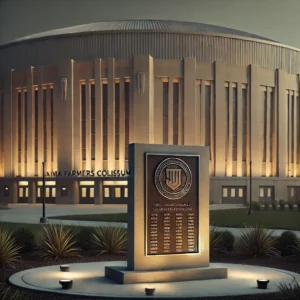The 1963 Indiana State Fairgrounds Coliseum gas explosion stands as one of the most devastating accidents in Indiana’s history. On the evening of October 31, 1963, a tragic explosion tore through the Indiana State Fairgrounds Coliseum, killing 74 people and injuring over 400 others. What was meant to be a joyous ice skating show turned into a night of horror and sorrow that is still remembered today.
The Events Leading Up to the Explosion
On that fateful Halloween night, thousands of spectators gathered at the Fairgrounds Coliseum in Indianapolis for the popular Holiday on Ice show. The arena was packed with over 4,000 people, most of whom were eagerly watching the graceful skaters glide across the ice.
Unknown to the crowd, a propane gas leak was occurring in one of the concession stands. Temporary heating units had been installed in the area, using liquid propane tanks. Over time, propane gas began leaking into the confined space beneath the seats near the concession area. With no ventilation to disperse the gas, it accumulated until it reached a dangerous concentration.
At approximately 11:00 PM, during a performance intermission, the gas finally ignited. The explosion that followed was catastrophic, ripping through the southwest corner of the arena. In an instant, the show turned into chaos as debris, metal, and concrete were hurled into the air, hitting the crowd.
Aftermath and Rescue Efforts
The blast caused an immediate power outage, plunging the arena into darkness. Panic spread quickly as spectators tried to flee the wreckage, unaware of the extent of the devastation. Emergency responders arrived at the scene within minutes, but the sheer scale of the disaster overwhelmed initial rescue efforts.
Survivors and first responders worked together to pull victims from the rubble. Triage areas were set up both inside and outside the building, and local hospitals were inundated with the wounded. Of the over 400 injured, many suffered critical injuries, while others dealt with severe trauma from witnessing the carnage.
Investigation and Blame
The explosion sparked an immediate investigation, revealing that the root cause was the improper use of the propane tanks. Investigators found that the tanks were improperly installed and lacked proper safety measures, allowing propane gas to leak unnoticed. The tank that fueled the explosion had been connected in a haphazard manner, leading to the tragic accident.
As a result of the investigation, new fire safety regulations were implemented across the state to prevent similar incidents. These laws specifically targeted the use of flammable gases in public venues, ensuring that strict safety protocols were followed for the installation and operation of such equipment.
Legacy of the Explosion
The aftermath of the disaster left a lasting mark on the community. Families grieved for loved ones lost in the explosion, and the entire state mourned. In the years that followed, memorials were erected to honor the victims. The Fairgrounds Coliseum itself underwent significant renovations, reopening in 1965 with enhanced safety features.
Today, the building, now known as the Indiana Farmers Coliseum, remains a functioning event venue. The tragic explosion of 1963, however, is not forgotten. A commemorative plaque at the site stands as a solemn reminder of the lives lost and the importance of safety in public spaces.

The Indiana Farmers Coliseum is still a symbol of resilience, having overcome one of the darkest moments in Indiana’s history. The memory of that night serves as a reminder to always prioritize public safety to prevent future disasters.
